Table of contents

jkuenstle.de
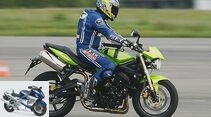
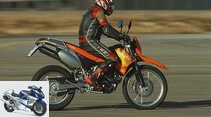
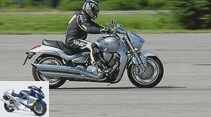
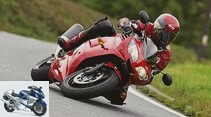
9 pictures
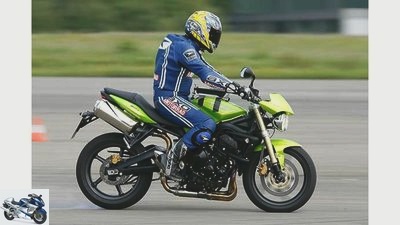
1/9
Braking properly without ABS: Your colleague shows you how: knees on the tank, upper body upright, view far ahead. The arms are slightly bent.
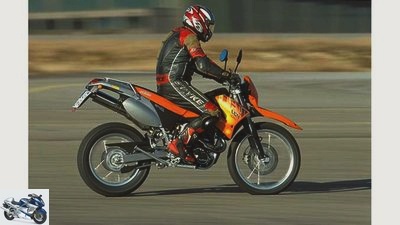
2/9
Braking properly without ABS: Long suspension travel and a high center of gravity put light enduros in danger of rollover. Brake at the back at the beginning.
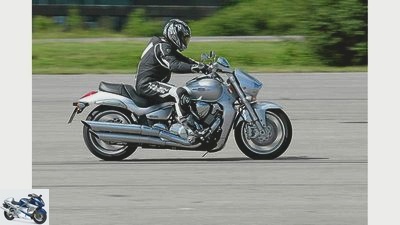
3/9
Braking properly without ABS: On cruisers, little weight is shifted forward – there is a risk of blockage. Strong use of the rear brake is advisable.
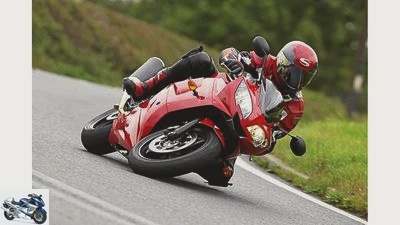
4/9
Braking properly without ABS: whether straight ahead or in a curve: If you brake too hard at the front, you have to react with lightning speed. The colleague in the picture was too slow.
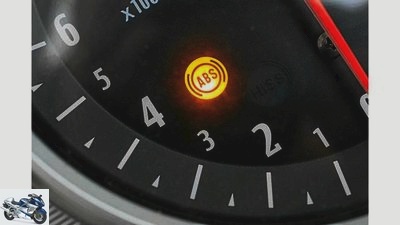
5/9
Regardless of whether with or without ABS: The physical limits are the same. Anti-lock braking systems help deal with them. They work best when used correctly.
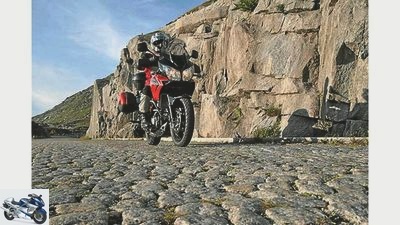
6/9
The braking distance is often surprisingly long on a poor road surface, even with ABS. So plan enough travel.
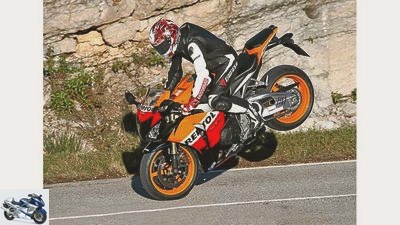
7/9
Super athletes tend to have stoppies when braking hard. Gradients or jumps in the coefficient of friction can exacerbate this tendency.
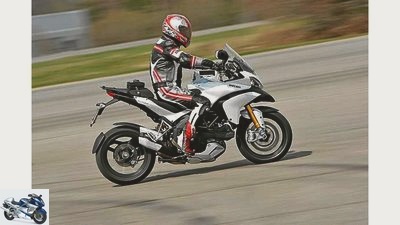
8/9
To prevent rollover, the Multistrada’s ABS was initially tuned to be mild. With new software it bites harder.
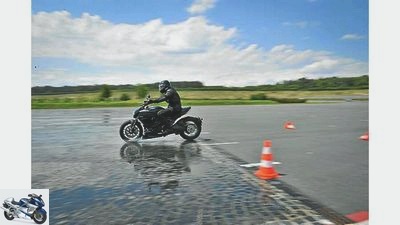
9/9
If you cramp on extremely slippery surfaces when braking, you run the risk of greasing the front wheel – despite ABS.
counselor
workshop
Guide: Braking correctly, part 1 – without ABS
Guide: Braking properly
Brake the motorcycle properly
Even if more and more motorcycles with ABS are registered in Germany, most of them still drive without it. The right strategy will help minimize this disadvantage. MOTORRAD shows how it’s done.
Tristan Staack
07/21/2011
Braking a motorcycle safely is a complex matter in everyday traffic and even more so in the event of emergency braking in a critical situation. Several levels of action form a difficult pattern of action, the individual components of which must be learned and practiced step by step. As the routine increases, all of these actions interlock and the processes become automated. Sounds complicated? It is. The correct operation of the hand and foot brake levers is only one of several tasks that the driver has to master. How well you brake is already influenced by your sitting position and body tension. If you loll around on the machine like on a sofa, it will be difficult to keep it on course during braking.
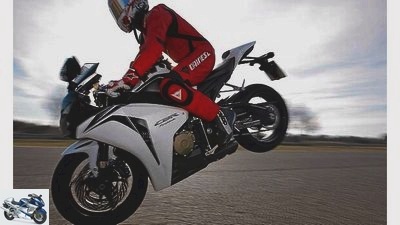
Do you want to avoid being thrown over the front? Then read on here.
It is important to find the right mix of body tension and looseness. So knees on the tank, keep your upper body upright and your arms bent. Anyone who becomes tense and leans their weight on the handlebars with straight elbows will not feel what the front wheel is doing and cannot react with the necessary sensitivity. Correct viewing is just as important. No matter how beautiful the treetops are reflected in the freshly refurbished tank, when braking it means: Keep your head up and look far ahead. This supports the sense of balance and the feeling for vehicle reactions. When braking in an emergency, it is extremely important to take your eyes off the obstacle. Whoever fixes it in a state of fright, usually rams it too. On the other hand, if you look into the free gap, you will find the way out.
Now it’s time to grab it! Without ABS it gets tricky. A blocked front wheel quickly leads to a fall because it cannot transmit any cornering force. If there is no system to protect against this, the driver has to take antiblocking action himself. The more weight it is placed on the tire, the more braking force it can transfer to the road. Due to the dynamic wheel load distribution when braking, the motorcycle moves further and further forward. In the extreme, the entire weight of the motorcycle including that of the rider, front passenger and luggage rests on the front wheel. If the driver jerks the brake lever, the front wheel locks before enough weight has shifted forward. If, on the other hand, the brake pressure increases continuously, within about half a second, the front wheel has enough time to absorb the load and the ideally warm tire can mesh with the road surface. So first apply the brakes lightly and then grip more and more, according to the maxim, as quickly as possible and as gently as necessary.
If you press the rear brake a fraction of a second before the front brake, you gain additional stability. The motorcycle pulls itself back into the spring, the rear wheel can run a little longer and transmit braking force. As MOTORRAD has found in many brake measurements, a small but reproducible gain in braking distance can be achieved, especially with light enduros or super athletes who tend to stoppies or even rollover. For this reason, the Combined ABS of the Honda CBR 600 RR and Fireblade operates the rear brake even if the driver only pulls the handbrake lever. This procedure is correct for every type of braking. Everyday, emergency or racetrack braking ultimately only differ in the dosage of the brake pressure.
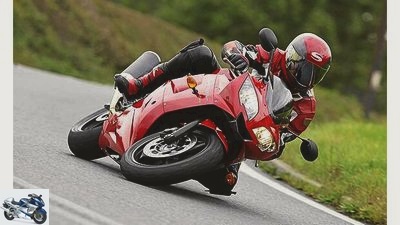
If you brake too hard, you have to react with lightning speed. The colleague in the picture was unfortunately too slow…
Should the front wheel lock up, only the lightning-fast release of the brake protects against the impending fall. While this takes some effort, it is the only way to regain control of the motorcycle. If you keep the bike close to the locking limit during the entire braking process, you will brake perfectly.
The rear wheel plays a subordinate role in braking. It is relieved more and more by shifting the wheel load, so that it can only transmit low braking and cornering forces. This leads to an increased tendency to lock, which is not to be trifled with on the rear wheel either. In this situation, a careless, clumsy steering impulse can cause the rear of the machine to swerve sideways, and even at a moderate lean angle, a blocked rear wheel can cause serious slides. In case of doubt, it is better to leave the rear brake under-braked after the initial impulse. Here, too, it would be ideal to move just before the blocking limit.
Overall, braking properly has a lot to do with routine. Even if everything fits, it is important to feel the motorcycle’s reactions early on. It takes a lot of practice to train this feeling and to automate the course of action. This can be done with caution and under certain conditions in normal traffic, but it is best done during safety training.
Build-up of brake pressure
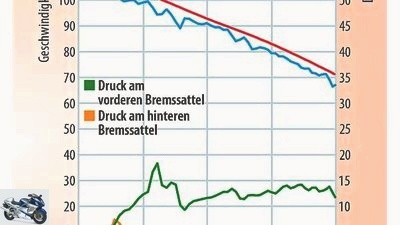
Build-up of brake pressure.
The diagram shows the ideal pressure build-up on the front and rear wheel brakes during full braking. “Normal” Braking should work the same way. A split second before pressing the front brake, the driver taps the rear brake. This pulls the motorcycle back into the spring and remains stable for a little longer while braking. The deceleration shifts the weight forward and the braking force on the hand lever can be increased considerably during the braking process.
MOTORCYCLE tip
Good braking starts with sitting properly. Knee closure and body tension help to support as little weight as possible on the handlebars. Build up the brake pressure quickly and continuously instead of pulling the lever suddenly. This prevents blocking. If it does, briefly release the brake and apply it again.

accesories
ABS put to the test
Motorcycle anti-lock braking systems in a comparison test
read more
Related articles
-
Braking properly with the motorcycle
Jahn counselor Driving experience & Driving tips Braking properly with the motorcycle Brake properly Braking with and without ABS Motorcycles ride well…
-
Suspension guide – correctly adjusting the damping, part 1
Photos: fact accesories landing gear & Spring elements Adjusting suspension / damping correctly, part 1 Guide: Adjusting the suspension / damping…
-
Suspension guide – correctly adjusting the damping, part 2
Cook counselor workshop Adjusting suspension / damping correctly, part 2 Guide: correctly adjusting the suspension / damping, part 2 A mystery for many:…
-
Guide to repairing spoked motorcycle wheels part 2
Marcel Schoch 15th pictures Marcel Schoch 1/15 The spokes, which are already slightly under tension after they have been lightened, lie firmly in the…
-
Guide to repairing spoked motorcycle wheels Part 1
Marcel Schoch 38 pictures Marcel Schoch 1/38 Preparatory work: The bike must always be removed for repairs. Damage to the tire can be an indication that…
-
MOTORCYCLE archive Sports & scene Braking with ABS An anti-lock braking system makes a lot of things easier Braking with ABS A motorcycle with an…
-
Motorcycle anti-lock braking systems in a comparison test
Jahn 13th pictures Jahn 1/13 The relations shift on the wet test track – in the truest sense of the word. Jahn 2/13 In conclusion, it can be said that…
-
Technology PS driving dynamics cornering ABS
markus-jahn.com 18th pictures markus-jahn.com 1/18 … as well as in the city to its limits. markus-jahn.com 2/18 On the one hand, this smooth transition…
-
Tuning and conversion guide Suzuki GSX-R 1000
Andreas Feulner 15th pictures Feulner 1/15 Performance and electronics – in these areas Suzuki has neglected the GSX-R 1000 badly. Nevertheless, it is…
-
Guide to changing the brake pads on the motorcycle
Ralf Schneider counselor workshop Guide to changing the brake pads on the motorcycle Change the brake pads on the motorcycle Tips from professionals…